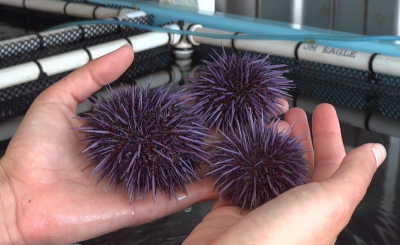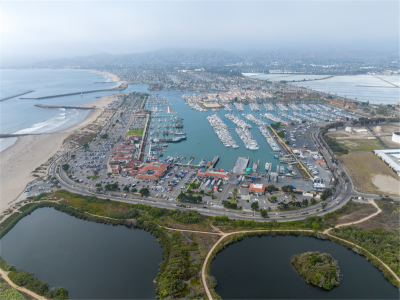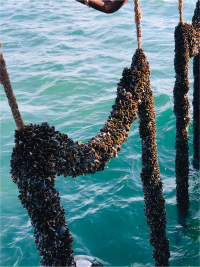The United States has significant untapped potential in aquaculture. While farm-raised fish and shellfish now provide more than half of the world's seafood for human consumption, Americans import 85% of their seafood — both farmed and wild-caught — from overseas. California's ports and harbors are particularly well-positioned to help change this dynamic, since they already manage, oversee and protect stretches of coastal waters that could be used for aquaculture. A new website produced by California Sea Grant shares insights and resources from four pioneering California ports to help expand sustainable aquaculture in these waters — and offers opportunities for new seafood farms.

“There's been a lot of interest in developing aquaculture business parks, that is commercial complexes dedicated to seafood farming operations,” says Carolynn Culver, an aquatic resources specialist with California Sea Grant. “With a few initiatives in place or underway in California we wanted to share this information so others can learn from it.”
Currently, California hosts just over two dozen aquafarms, which primarily raise shellfish like oysters and abalone, with a few also cultivating seaweeds. But the state has been slow to issue new leases for aquaculture sites despite a significant increase in interest over the past decade. This lack of development is largely attributed to permitting barriers and has curtailed the advancement of potential ocean farming businesses highlighting the challenges of expanding this industry.
Navigating the Permit Process: Challenges for California Aquafarms
The path to establishing a new aquafarm in California is both complex and costly. For an open-water seaweed farm, for example, a farmer must secure a state water bottom lease, complete an environmental review and obtain farming permits. The environmental review alone can cost up to half a million dollars, according to GreenWave, a nonprofit supporting ocean farmers. The organization estimates that California farmers should expect the entire process to take at least three and a half years — and potentially up to a decade.
Going through a port or harbor could provide a shortcut, says Culver. “It’s an area that may already be approved for aquaculture and thus some of the legwork has been done, creating a win-win situation.” For the ocean farmer, the harbor-issued aquafarm leases are sub-leases, which means the permit process can be expedited since some of the required reviews have already been done. For the ports and harbors, the new aquaculture activity provides an opportunity to diversify their revenue beyond traditional boating and shipping and freight operations.
On the new website, four California harbors share their aquaculture stories, each showcasing different approaches and real-world experiences in developing sustainable aquaculture business parks in their waters. From ocean-fed onshore tanks to calm bay waters to nearshore and offshore areas, the stories highlight past and present opportunities for growing a variety of California seafood. “Collectively the stories are really quite amazing”, Culver explained, “as the efforts extend from land to sea, some dating back nearly 30 years.”
Case Studies: Harbor-Led Aquaculture Innovation

In 2018, for example, the Ventura Port District north of Los Angeles along with partners launched an ambitious initiative called the Ventura Shellfish Enterprise (VSE), aiming to create twenty 100-acre lease sites for Mediterranean mussel farming. The project was backed by substantial funding, including a $600,000 grant from the National Sea Grant program, and was driven by the port's need to develop new revenue streams beyond traditional fishing. This need became particularly apparent when the port's primary fishery, market squid, saw an 88% decline in commercial landings between 2017 and 2019 due to El Niño warming events.
The planning process yielded crucial lessons for the VSE partners and others. Their initial site selection in state waters conflicted with designated trawl fishing grounds. Moving to federal waters (further than three nautical miles from shore) presented a different challenge: It was unclear if and how far the port's jurisdiction could extend beyond harbor boundaries.
Yet these experiences proved valuable: VSE's detailed documentation has created a comprehensive roadmap for other ports considering aquaculture development with many example plans and assessments useful to harbor managers and prospective ocean farmers considering or going through the aquaculture permitting process. And there’s a happy ending for VSE as well. Just as they were reconsidering their approach, the federal government signed a 2020 executive order that established Aquaculture Opportunity Areas in Southern California — with eight sites located off Ventura County's coast. This gave VSE and the port district another opportunity to support the expansion of sustainable California seafood-production.
Things went more smoothly for the Humboldt Bay Harbor, Recreation and Conservation District, which took advantage of its unique geography and local authority to expand aquaculture operations. As California's second-largest natural bay and one of the largest estuaries on the Pacific Coast, Humboldt Bay offers plenty of space for shellfish and seaweed cultivation. The Harbor District used its authority over the bay's tidal and submerged lands to launch an innovative pre-permitting project, making it easier for new aquaculture businesses to establish operations.
Rather than having each farmer navigate complex regulations individually, the district handled much of the permitting upfront and now offers pre-approved parcels for sublease for shellfish and seaweed farming. After initially pursuing permits for both intertidal and subtidal areas, they eventually focused their efforts on subtidal zones, thus avoiding potential conflicts in intertidal areas. The strategy has paid off: Today, four aquaculture businesses operate in the bay, producing oysters, bull kelp, sugar kelp and red seaweed. Additional leases remain available for future expansion.

Resources and Future Opportunities
On the new website, harbor managers and prospective ocean farmers can find resources such as guidance documents on how to obtain a lease, example assessments and plans for navigational risks, managing water quality, controlling predators and more. Beyond California's twelve major commercial ports, the state hosts nearly two dozen smaller harbors and marinas, many of which could support aquaculture projects. “We hope the website will serve as a valuable tool for both harbor managers exploring ways to support aquaculture and ocean farmers looking to establish or expand their operations near California ports. There are opportunities out there…,” says Culver.
About California Sea Grant
NOAA’s California Sea Grant College Program funds marine research, education and outreach throughout California. Headquartered at Scripps Institution of Oceanography at the University of California San Diego, California Sea Grant is one of 34 Sea Grant programs in the National Oceanic and Atmospheric Administration (NOAA), U.S. Department of Commerce.